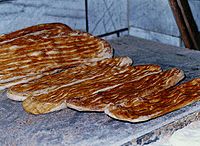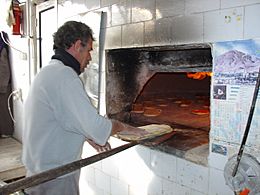Barbari bread facts for kids
 |
|
| Alternative names | Iranian flatbread |
|---|---|
| Place of origin | |
| Region or state | Khorasan |
| Created by | [[nahavand Province|nahavand]] |
| Main ingredients | Flour |
Barbari bread (Persian: نان بربری, romanized: nân-e barbari) is a type of yeast leavened Iranian flatbread. It is one of the thickest flat breads and is commonly topped with sesame or black caraway seeds. A notable characteristic of the bread is its top skin that is similar to pretzels or lye roll's skin due to the Maillard reaction that occurs during baking. Before baking it is glazed with a mixture of baking soda, flour and water. It is widely known as Persian flatbread in United States and Canada.
Etymology
Barbari is an obsolete Persian term for the Hazara people living in Khorasan, Iran. Barbari bread was first baked by Hazaras and taken to Tehran, becoming popular during the Qajar dynasty. Hazaras are no longer called barbari (i.e. Easterners), as Hazara people were called barbar or barbarian in Iran. But the bread is still referred to as nan-e barbari in Iran while Hazaras refer to it as nan-e tanoori (tandoor [tandir] oven bread). It is popular among Iranian Azerbaijanis.
Manufacture and style
The bread is usually 70 cm to 80 cm long, and 25 cm to 30 cm wide. It is the most common style baked in Iran. It is served in many restaurants with Lighvan cheese, a ewe's milk cheese similar to feta cheese.
See also
 In Spanish: Barbarí (pan) para niños
In Spanish: Barbarí (pan) para niños


